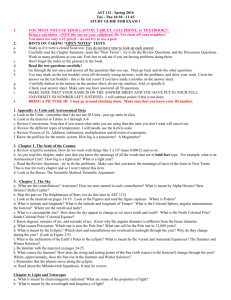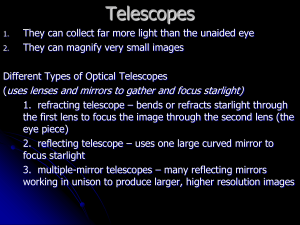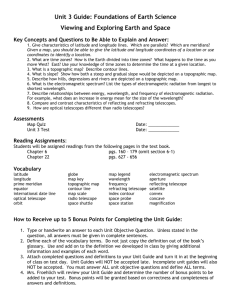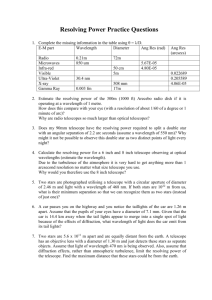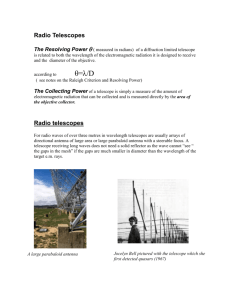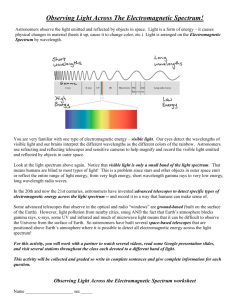AST 111: Tu-Thu 10:30am - 11:45am STUDY GUIDE FOR EXAM 2
advertisement
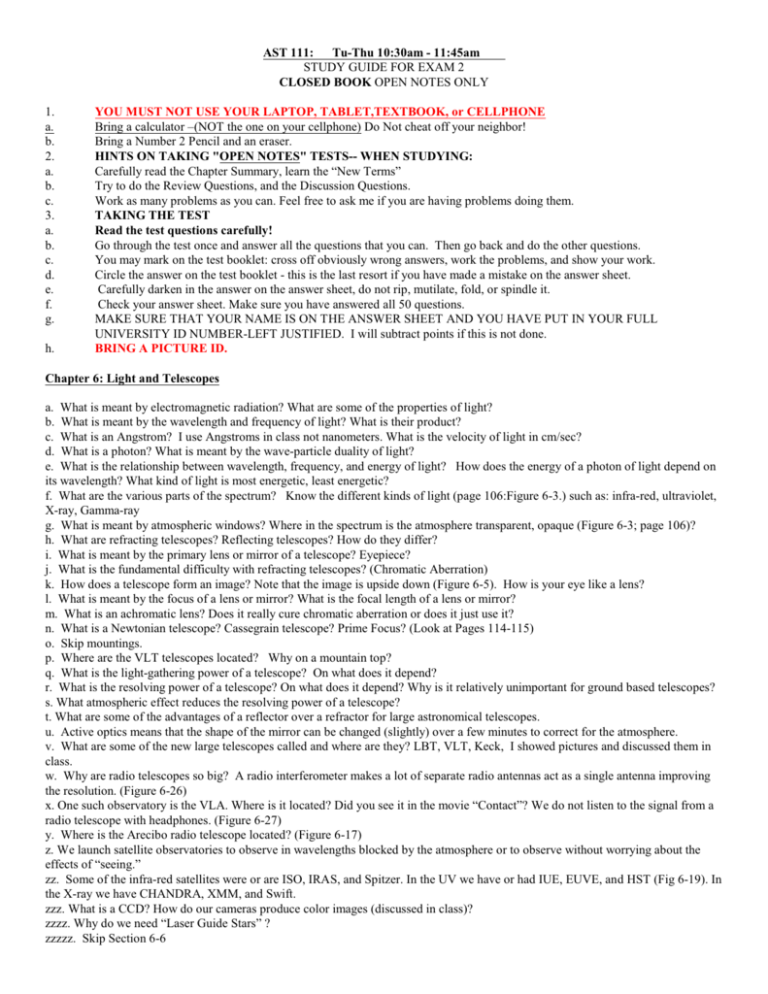
AST 111: Tu-Thu 10:30am - 11:45am STUDY GUIDE FOR EXAM 2 CLOSED BOOK OPEN NOTES ONLY 1. a. b. 2. a. b. c. 3. a. b. c. d. e. f. g. h. YOU MUST NOT USE YOUR LAPTOP, TABLET,TEXTBOOK, or CELLPHONE Bring a calculator –(NOT the one on your cellphone) Do Not cheat off your neighbor! Bring a Number 2 Pencil and an eraser. HINTS ON TAKING "OPEN NOTES" TESTS-- WHEN STUDYING: Carefully read the Chapter Summary, learn the “New Terms” Try to do the Review Questions, and the Discussion Questions. Work as many problems as you can. Feel free to ask me if you are having problems doing them. TAKING THE TEST Read the test questions carefully! Go through the test once and answer all the questions that you can. Then go back and do the other questions. You may mark on the test booklet: cross off obviously wrong answers, work the problems, and show your work. Circle the answer on the test booklet - this is the last resort if you have made a mistake on the answer sheet. Carefully darken in the answer on the answer sheet, do not rip, mutilate, fold, or spindle it. Check your answer sheet. Make sure you have answered all 50 questions. MAKE SURE THAT YOUR NAME IS ON THE ANSWER SHEET AND YOU HAVE PUT IN YOUR FULL UNIVERSITY ID NUMBER-LEFT JUSTIFIED. I will subtract points if this is not done. BRING A PICTURE ID. Chapter 6: Light and Telescopes a. What is meant by electromagnetic radiation? What are some of the properties of light? b. What is meant by the wavelength and frequency of light? What is their product? c. What is an Angstrom? I use Angstroms in class not nanometers. What is the velocity of light in cm/sec? d. What is a photon? What is meant by the wave-particle duality of light? e. What is the relationship between wavelength, frequency, and energy of light? How does the energy of a photon of light depend on its wavelength? What kind of light is most energetic, least energetic? f. What are the various parts of the spectrum? Know the different kinds of light (page 106:Figure 6-3.) such as: infra-red, ultraviolet, X-ray, Gamma-ray g. What is meant by atmospheric windows? Where in the spectrum is the atmosphere transparent, opaque (Figure 6-3; page 106)? h. What are refracting telescopes? Reflecting telescopes? How do they differ? i. What is meant by the primary lens or mirror of a telescope? Eyepiece? j. What is the fundamental difficulty with refracting telescopes? (Chromatic Aberration) k. How does a telescope form an image? Note that the image is upside down (Figure 6-5). How is your eye like a lens? l. What is meant by the focus of a lens or mirror? What is the focal length of a lens or mirror? m. What is an achromatic lens? Does it really cure chromatic aberration or does it just use it? n. What is a Newtonian telescope? Cassegrain telescope? Prime Focus? (Look at Pages 114-115) o. Skip mountings. p. Where are the VLT telescopes located? Why on a mountain top? q. What is the light-gathering power of a telescope? On what does it depend? r. What is the resolving power of a telescope? On what does it depend? Why is it relatively unimportant for ground based telescopes? s. What atmospheric effect reduces the resolving power of a telescope? t. What are some of the advantages of a reflector over a refractor for large astronomical telescopes. u. Active optics means that the shape of the mirror can be changed (slightly) over a few minutes to correct for the atmosphere. v. What are some of the new large telescopes called and where are they? LBT, VLT, Keck, I showed pictures and discussed them in class. w. Why are radio telescopes so big? A radio interferometer makes a lot of separate radio antennas act as a single antenna improving the resolution. (Figure 6-26) x. One such observatory is the VLA. Where is it located? Did you see it in the movie “Contact”? We do not listen to the signal from a radio telescope with headphones. (Figure 6-27) y. Where is the Arecibo radio telescope located? (Figure 6-17) z. We launch satellite observatories to observe in wavelengths blocked by the atmosphere or to observe without worrying about the effects of “seeing.” zz. Some of the infra-red satellites were or are ISO, IRAS, and Spitzer. In the UV we have or had IUE, EUVE, and HST (Fig 6-19). In the X-ray we have CHANDRA, XMM, and Swift. zzz. What is a CCD? How do our cameras produce color images (discussed in class)? zzzz. Why do we need “Laser Guide Stars” ? zzzzz. Skip Section 6-6 Chapter 7. Starlight and Atoms. a. Remember the structure of an atom (nucleus with protons and neutrons plus electron(s) orbiting the nucleus) b. What is meant by neutral, ionized, electron orbits. Remember that all matter consists of atoms. Each atom consists of a nucleus with electron(s) in orbit around the nucleus. (Page 131) c. The nucleus consists of proton(s) and neutron(s). Know what is meant by atomic number and atomic weight. What is an isotope? d. The Coulomb force binds the electrons to the nucleus. e. The various orbits around the nucleus are called energy levels because it takes energy to move away from the nucleus or the atom must give up energy for the electron to jump back toward the nucleus. Remember that only certain energies (distances from the nucleus) are permitted. (Stairway analogy) f. What is an excited atom? Ground state? g. The key concept about thermal emitters is that they emit radiation in a pattern that depends only on their temperature not their surfaces. So we ignore reflected light. h. Peak wavelength, which I use in class, is the same as wavelength of maximum intensity (p. 137). i. Look at Figure 7-6 in order to understand the three laws of thermal emission. Know the three “laws” as given in class. He leaves out the first one: That a hotter thermal emitter emits more energy at every wavelength than a cooler thermal emitter. j. What is the Stefan-Boltzmann Law? Wien’s Law? How can we use Wien’s Law to determine at what wavelength a thermal emitter radiates most strongly.? The value of the constant given in class is 5000 * 6000 because I use Angstroms not nanometers. k. Know Kirchhoff’s Laws as given on page 140-141: (1) A hot solid or dense gas produces a continuous spectrum. (2) A low density excited or hot gas produces a bright, emission line spectrum. (3) Put a low density gas in front of a continuous spectrum and you get a continuous spectrum with dark, absorption lines superimposed. l. Know emission and absorption lines and where and how they are formed. m. What is the Doppler Effect or Doppler Shift. How can we use it to tell whether an object is moving toward or away from us? What is meant by a blue shift? A red shift? n. Review the uses of the Doppler effect that I discussed in class. o. Skip the Doppler formula on page 143 p. Try to do problems 1 and 2 on page 145 Chapter 8. The Sun Know the data on Page 148 1. What is the photosphere, the chromosphere, the corona? 2. What is granulation? What is it telling us about heat flow from the interior? How long does a granule last? (Figure 8-2) 3. What is Convection? Conduction? Radiation? (Discussed in class) 4. What is supergranulation? Spicules are found at the edges of supergranules. How long do they live? 5. How does the temperature of the Sun’s visible layers vary with height above the photosphere? (Figure 8-3) 6. How far does the Corona extend into space? How hot is the corona? What is the Solar wind? 7. Helioseismology is the study of the interior of the Sun using the Sun’s oscillations in radius. We can study the interior of the sun just as ringing a bell tells us how the bell is made. (Figure 8-7) 8. What are Sunspots? (Look carefully at Figure 8-8: Never stare or point a telescope at the Sun) 9. What is the 11 year Sunspot cycle? The 22 year magnetic cycle? (Page 158-159) Where are we in the current Sunspot cycle? (discussed in class) 10. What are flares, prominences, filaments? (Page 162-163) 11. What is the butterfly diagram (P. 158-159)? What does it tell us about the Sunspots during the cycle? 12. What is meant by the Maunder minimum in the numbers of Sunspots? 13. Where does the energy from the sun come from? Why do we know that it must be nuclear energy? 14. Binding energy is the energy that keeps the protons and neutrons in the nucleus from flying apart. 15. Nuclear Fusion requires high temperatures and high densities to overcome the Coulomb barrier. (Because like charges repel) 16.What is the proton-proton chain? (See Figure 8-15) 17. What is a neutrino? How is energy released in the proton-proton chain? Deuterium is an isotope of hydrogen. 18. How does the energy flow from the center to the surface? Where is convection important? Radiation? 19. What is the difference between nuclear fusion and nuclear fission. Which is most important in current nuclear power plants like Palo Verde? 20. What does the solar neutrino experiment tell us? What are the most recent results: Discussed in class. 21. Who is the person who built the Homestake Mine experiment and was awarded the Nobel Prize? (Page 169)
